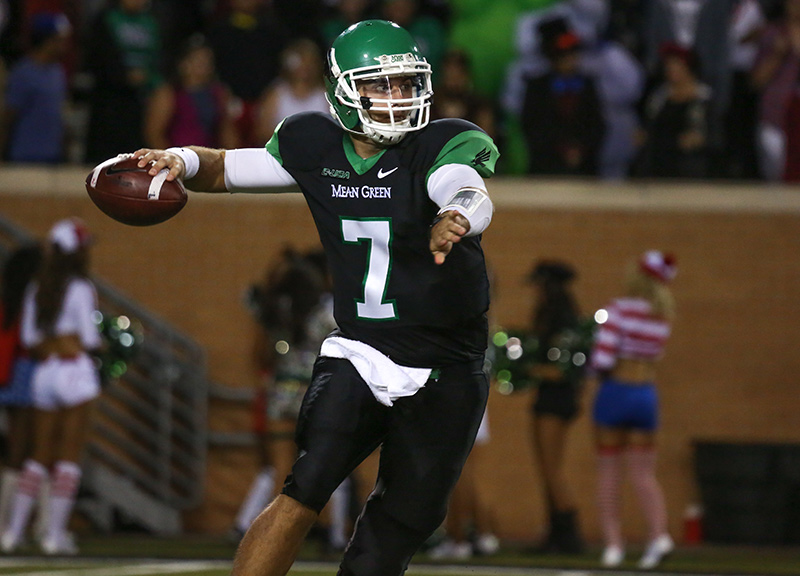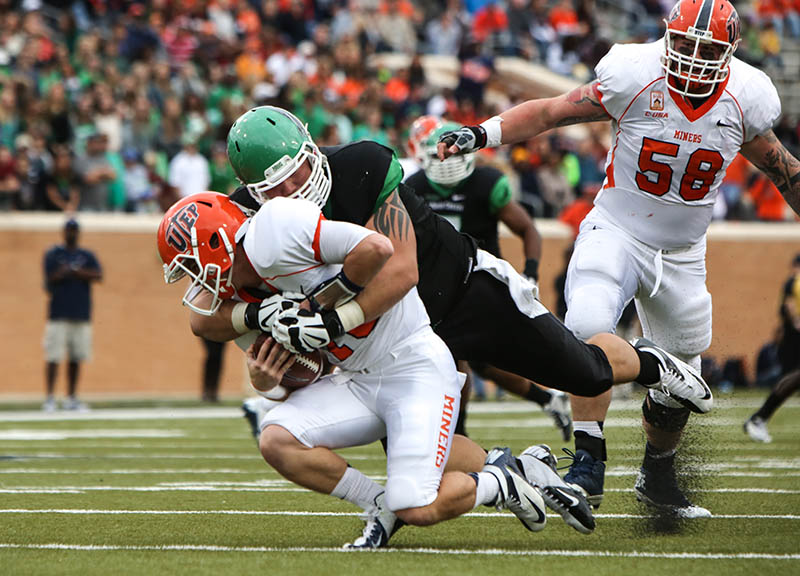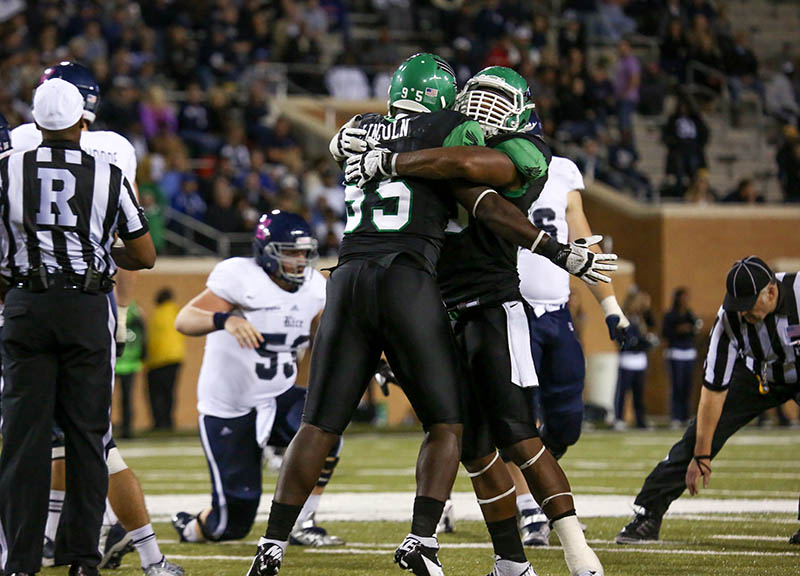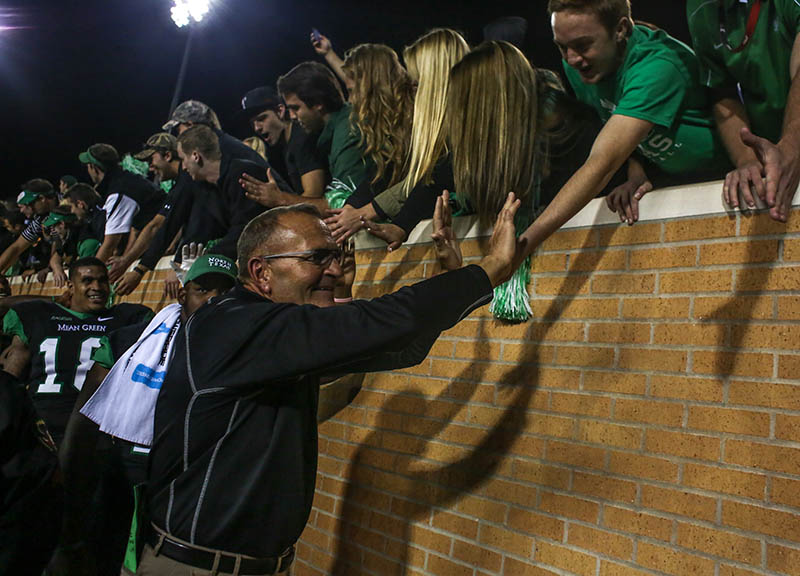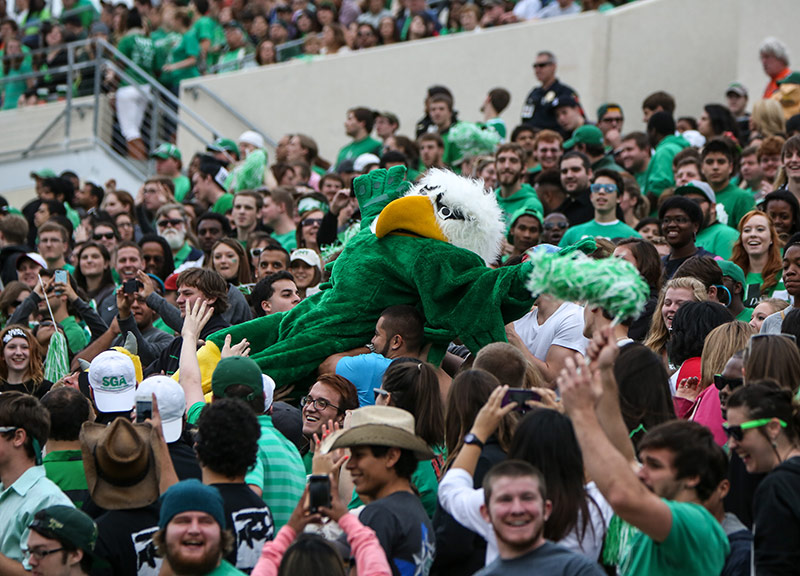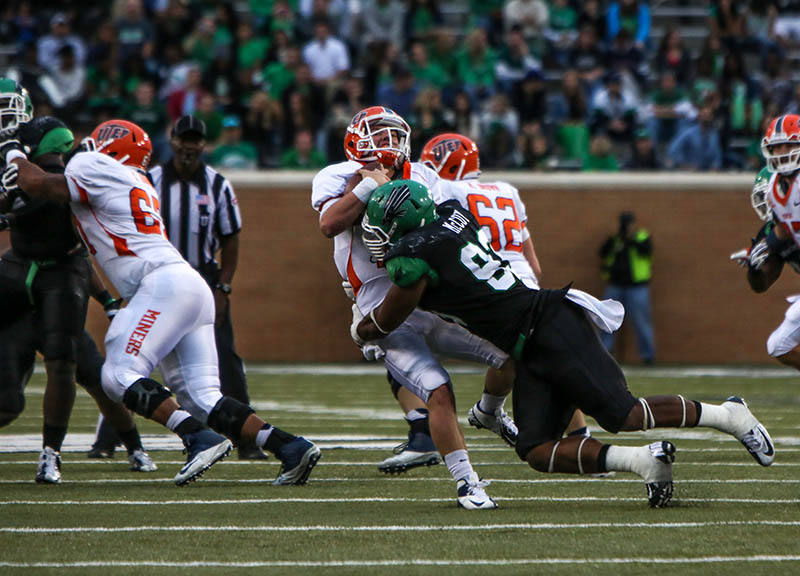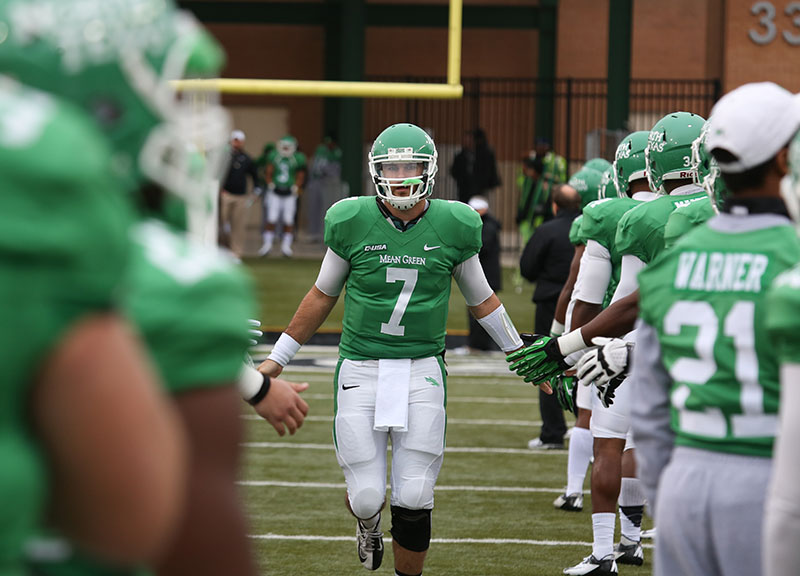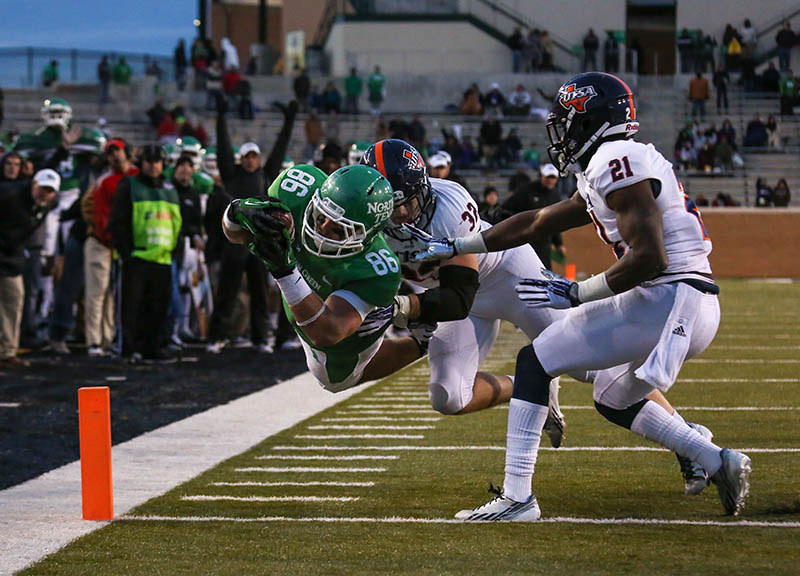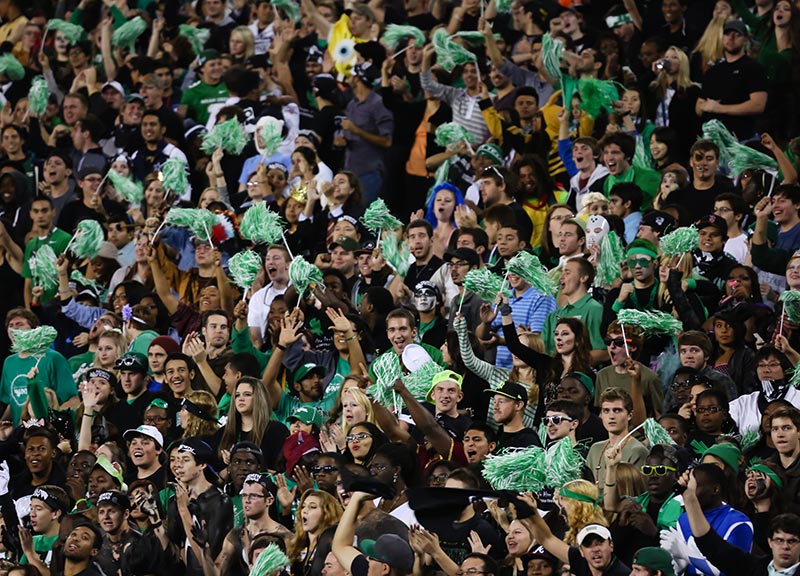Getting The University of North Texas Football Team Back to Bowl Play Hasn't Been Easy.
To understand where the University of North Texas football program is these days — in a new conference, in new facilities, with a bowl berth for the first time since 2004, and all — one must understand where it's been.
Remember: As recently as the 1994 football season, UNT wasn't even a Division 1-A (now Football Bowl Subdivision) program.
The school was forced to move down to what was then Division 1-AA (now the Football Championship Subdivision) in 1983 after failing to meet NCAA attendance requirements for 1-A schools. The effects of the drop, which included further declines in attendance and a decrease in athletic revenue, led to one of the darkest periods in UNT's football history.
The teams were bad. Attendance was worse.
There was a general malaise about the program — something that would persist for over a decade — and it wasn't undeserved.
But, through a concerted effort by boosters and the school to increase funding, revenues and ticket sales, UNT was able to rejoin Division 1-A for the 1995 season. The following year, the school would join the Big West Conference and fully reintegrate itself into the top tier of college football divisions.
Thing is, the team still wasn't any good. And the fans still weren't showing up.
The boost in attendance that precipitated the 1-A move was essentially imaginary. Well-meaning boosters purchased large swaths of season tickets — seats that no one sat in during games. UNT football was still fundamentally the same program as it was, only it was now playing on a much bigger field.
During its time in the Big West, the team never even sniffed a bowl game berth, much less a conference championship. In five seasons, the Mean Green went 17-38.
Perhaps weary of the consistent beatings, UNT left the Big West for the friendlier confines of the Sun Belt Conference in 2001. For a brief period, things seemed to be turning around: Coach Darrell Dickey led the Mean Green to four consecutive league championships and berths in the New Orleans Bowl.
Things were improving on the field, and substantially at that.
“We had talented players and a coaching staff that put us in a position of being successful,” says Johnny Quinn, a star receiver for three of those Sun Belt championship teams and a current member of the USA National Bobsled team. “We capitalized on the opportunity for us, and ended up going to a lot of bowl games.”
Despite Quinn, his coaches and his teammates' efforts, however, the off-the-field situation just saw more of the same from the program. Attendence still floundered. Practice facilities weren't up to par. Worst of all for the program, Fouts Field — the Mean Green's home since 1952 — had become a crumbling eyesore.
“I've been around a lot of programs,” says UNT athletic director Rick Villarreal, remembering when he arrived at the school in 2004. “And [UNT] was definitely, by far, the worst program I had ever been around.”
The bones of the program simply couldn't sustain Dickey's successes. So, after going 3-9 in 2006, he was fired.
After Dickey's firing, things quickly went from bad to awful. Todd Dodge, then the coach of Southlake Carroll and winner of four state championships, was hired to take Dickey's place. But Dodge's tenure was nothing short of atrocious, culminating in his being dismissed after a 1-6 start to the 2010 season.
“The first year I was here was the Todd Dodge era,” remembers UNT alum Tyler Sloan. “We were winning two or three games at the most per year. The games would get out of hand early. Everybody would want to leave early and I'd try to make them stay for the rest of the game. The atmosphere was bad. The defense would give up 60-something points per game.”
Sloan attended UNT for four football seasons. Over that stretch, the Mean Green went 11-37.
Obviously, like so many other times in UNT football history, a change in direction was needed. And, this time, Villarreal and his department were able to make things work in their favor.
For starters: Apogee Stadium, the school's gleaming, forward-thinking, $78 million football palace was completed in time for the 2011 season's start. Secondly: Villarreal was able to hire Dan McCarney as the team's head coach, just in time for the stadium's inaugural season.
McCarney brought sorely needed big-game experience with him to the program from his time as an assistant at the University of Iowa and the University of Wisconsin, as well as the knowledge of how to rebuild a struggling program from his years as Iowa State's head coach.
At first, the gains were incremental.
In 2011, McCarney led his team to five wins — as many as the school had won in the previous two seasons combined — and the fans began coming back, too. The 113,186 paid admissions to 2011 home games set a school record.
In 2012, despite a 4-8 record that could in part be blamed on a tough schedule, the Mean Green continued its improvement, best exemplified by the team's hanging with Kansas State well into the fourth quarter on the road. That KSU team was ranked in the top 15 in the national polls at the time and would go on to win the Big 12 Conference Championship.
The improved program, the ever-shifting football conference landscape and increased fundraising began to make UNT an attractive option for conferences looking to expand. And when Conference USA needed a new team, it came calling.
Villarreal couldn't turn down the opportunity. UNT became an official member of the league on July 1 of this year.
Despite the preseason perceptions of North Texas heading into the new conference — the team was picked to finish ninth in the 12-team league — the Mean Green flourished in the new league, flirting with a division championship for most of the season and finishing the season with eight wins, the school's highest total since 2003.
“Everybody said, 'Hey, when you make the transition to Conference USA, be prepared to be at the bottom,'” Villarreal says. “So I told our kids that we weren't preparing to be at the bottom. That's not what we've been building facilities and hiring coaches for. We've been preparing for this time for a long time.”
What Villarreal doesn't say is that there were multiple risks involved in taking the leap. Sure, Conference USA has been one of the premiere non-BCS leagues in college sports since its inception. But the schools primarily responsible for that success have moved on: Louisville left to join the Big East and will soon be part of the ACC; TCU is now a member of the Big 12; and Memphis, whose basketball success was the face of C-USA in the aughts, recently joined the newly formed American Athletic Conference.
As UNT begins this new chapter in the C-USA, all that's left is, largely, is a TV contract, a name and, fortunantely for UNT, bowl tie-ins.
Had UNT still been in the Sun Belt this year, 8-4 might not have been good enough for a bowl bid. Of the seven teams in that conference to reach the six wins necessary for bowl eligibility this season, only two received bids.
C-USA, on the other hand, has six tie-ins, ensuring that at least a majority of bowl-eligible teams in the conference will get to enjoy the postseason — something that Quinn believes is especially important to a growing program.
“As an alumni and a former football player from North Texas, it's exciting,” he says. “We're back in bowl contention. I remember just how special it was for us, and I can imagine it's the same for those guys in that locker room. Now that UNT is bowl-eligible? What a reward to the upperclassmen who've been there through the tough times. And now they're starting to see their efforts pay off. As a fan, an alumni of the school, I'm just extremely proud of our program.”
Pride is one thing. But just as important as those direct advantages are the side benefits that a bowl berth provides.
“You won't make necessarily a lot of dollars from the bowl game,” Villarreal says. “It'll come from the residuals involved — the merchandise you sell, the number of donors that come join the Mean Green Club and write a check, join the President's Council, whatever.”
UNT won't have to allocate much of that money to its travel budget either: On Sunday, the team found out that it had been invited to play in the Heart of Dallas Bowl on New Year's Day against the University of Nevada, Las Vegas.
UNLV isn't a marquee opponent by any stretch, but that doesn't mean the game is without intrigue. Questions abound. Can UNT win a bowl game for just the second time in its history? How hungover will students be for the 1 p.m. kickoff? How weird is it that Neal Smastresk, UNT's incoming president, is also currently UNLV's president?
Those queries, combined with the HoD Bowl's historic Cotton Bowl setting, give the matchup plenty of spice.
Plus, it's infinitely better than the alternative.
“For a school like [UNT], in a bowl game, if your logo is on TV everyday for three weeks and your team is on national TV 15 times on five networks or youâ��re in every newspaper — you can't put a dollar value on that,” says Villarreal.
As we've chronicled all season, UNT is a football program on the way up. Villarreal, a supportive administration and McCarney have solidified a platform for a level of sustained success — one unseen in the program's history to this point.
It seems Mean Green Nation's best football days may still be coming — brighter and sooner than could have been anticipated.
All photos by Mikel Galicia.
